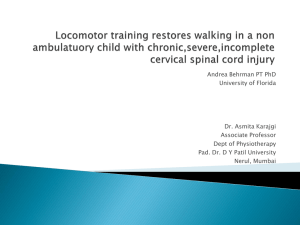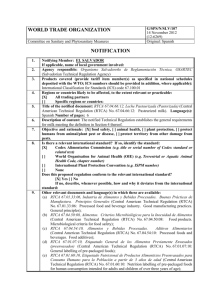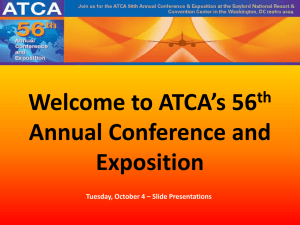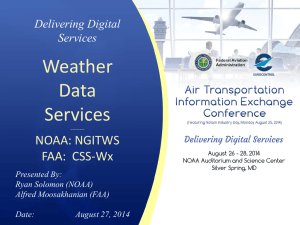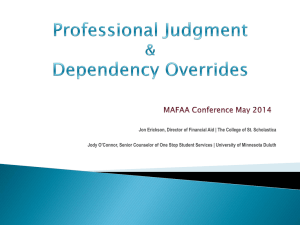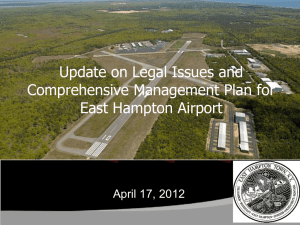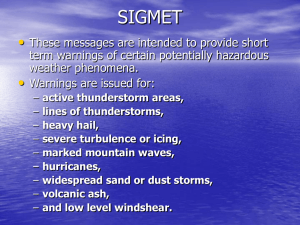Tim Rahmes - Boeing, Ernie Dash - AvMet
advertisement
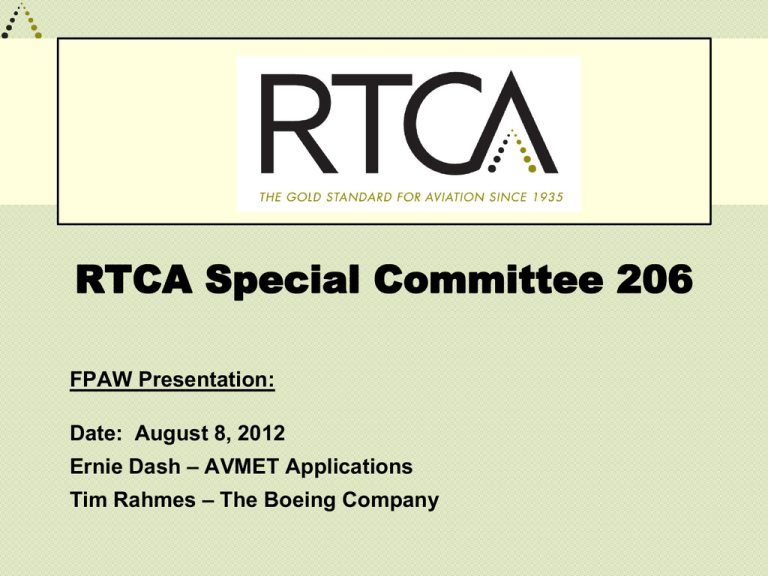
RTCA Special Committee 206 FPAW Presentation: Date: August 8, 2012 Ernie Dash – AVMET Applications Tim Rahmes – The Boeing Company What You Will Hear Process – Standards Development • RTCA Approach – FAA Use Industry Motivation Relevant Data Link Architecture RTCA SC-206 Examples • ConUse for MET and AIS Data Link Services • OSED for Wake Vortex, Air Traffic Management and Weather Applications • RTCA SC-206 Workplan - Recruiting 2 Process 3 RTCA Approach – FAA Use RTCA Docs FAA Docs TSOs MOPS Aircraft Avionics Specs FAA certification of aircraft avionics MASPS Overall System Specs ACs, AIM, Other FAA operations approval/guidance SPR/INTEROP OSED ConOps / ConUse Bottomline: An OSED or ConOps/ConUse are the basis for developing System(s) Performance Specifications 4 RTCA Approach – Documents Scope OSED = Operational Services and Environment Definition • • Provides description of a proposed Service Describes • How it will work • Where it will work • Under What Conditions it will work • What are the potential Benefits ConOps / ConUse – follow basic FAA outline • Contents and purpose similar to an OSED SPR = Safety and Performance Requirements (3 Main Components) • OSD – Operational Service Description • • Based on an OSED OSA – Operational Safety Assessment • Establishes Integrity Requirements • • Integrity = Service Quality/Corruption Risk OPA – Operational Performance Assessment • Establishes Timing, Availability and Continuity Requirements • • • Timing = Time to complete action (latency) Availability = Service available risk to one/all users Continuity = Service interruption risk INTEROP = Interoperability Requirements • Identifies requirements (technical, interface and functional) for a specific technology (or mix) needed to operate successfully per the SPR/OSED 5 Level of Effort SPR / INTEROP MASPS / MOPS OSED If OSED is not done well – SPR / INTEROP / MASPS / MOPS are at risk - !! 6 Motivations For Our Industry 7 CDM and Exchange of MET/AIS Data Flight Crew Needs - Hazard avoidance - Flight optimization - Diversion - Operating restrictions - Departure, destination and alternate information Aircraft A/C Observations - Increased AMDAR equipage - Increased AMDAR reporting - New/improved parameters MET & AIS MET only MET & AIS ANSP AOC Preflight & Future Inflight Coordination Airport Improved connectivity will provide better data collection and dissemination 8 Concepts for NextGen Industry Standards Activities (e.g., RTCA SC-206) Uplinked AIS Uplinked Weather Benefits: Weather Display/Integration Graphical and Database Needs Increase situational awareness Convective weather NOTAMs (e.g. TFRs, SAA) Reduced fuel & emissions FM, AMM, EGPWS, EFB, etc. Turbulence avoidance/alerts On-time performance NextGen Compatibility Winds/temps aloft Passenger ride comfort Applicable to time-limited non Reduced injuries Volcanic ash weather constraints (e.g., traffic Reduced maintenance Icing congestion) Reduced pilot/controller Lightning workload SIGMETs AIREPs/PIREPs Benefits w/observations advancements: RVR, runway conditions • • • • Better weather forecasts Capacity increases likely (e.g., wake turbulence mitigation) Atmospheric modeling contribution Environmental constraint mitigation Potential real-time sharing of in situ observations • To flight deck (e.g., wake turbulence, windshear events) Crosslink Weather Increased use of aircraft as sensor platform AMDAR parameters (e.g., wind, temp, EDR turbulence, water vapor, icing) Near real time data needs of sensed data in flight deck (e.g., wake turb, wind-shear events) Future needs (e.g., HIWC needs) Downlink Weather 9 Relevant Architectures 10 ConUse Recommended Architecture AIS and MET Services Physical Architecture (Notional) 11 RTCA SC-206 Examples 12 AIS, MET, & ATM Information Categories (AIS/MET ConUse) Flight Scenario Situational Awareness Information Categories Services Hazard Avoidance Term Ops Diversion En Route Route Alt Chng Dev Pre Flt Sfc Ops Term Ops En Route OCN Polar RMT X X X X X X X Convective Activity X X X X X X X X X Turbulence X X X X X X X X X Icing/Freezing X X X X X X X X X Microburst X X X Wind shear X X X Wake Turbulence X X X Volcanic Ash X Optimize Flight MET AIS Destination Emergency e.g., medical Surface/ Terminal En Route WPDS WNDS WIDS X X X X X X X X X X X X X X X X X X X X X X X X X X X X X X X X X X X X X X X X X X X X X X BSS AUS MET Examples Airport/ Aerodrome Wx Hazardous Weather X X X X X X X X X X X X X X X X X X X X X X X X X X X Winds/Temps Flight Path X Arrival/Departure X X X X X X Aerodrome Map Aerodrome Info X X X X X X X X X X X X Airspace and Comm X X X X X X X X X X X X Electronic Charts X X X X X X X X X X X X Geopolitical X X X X X X X X BSS Examples X X Magnetic Field/Flux X Navigation X X X X X X X X X X X X Obstacle X X X X X X X X X X X X Terrain X X X X X X X X X X X X Miscellaneous X AUS Examples Aerodrome X X X X X Airspace X X X X X X X X X Services X X X X X X X X X Points & NAVAIDs X X X X X Communications X X X X X Surveillance X X X X X Procedures X X Routes X Obstacles X X X X X X X X X X X X X X X X X X X X X X X X X X X X X X X X X X X X X X X X X X X X X X X X X X X X X X Miscellaneous X Air Traffic Mgmt Examples Traffic Flow Info X X X X X X X X X X X ATC Procedures X X X X X X X X X X X 13 Meteorological Parameters to be Transmitted (DO-339 OSED) Data Field # of bits Range LSB/Comments Wind Speed 8 0..255 knots Wind Direction 9 0…359 degrees Static Air Temperature 9 -128..127.5 degrees C Static Air Pressure 11 0..2047 hPa Average Turbulence Metric (EDR1/3) 8 0..1.27 in EDR1/3 units Humidity/water vapor 7 0..100% Peak Turbulence Metric (EDR1/3) 8 0..1.27 in EDR1/3 units 1 knot 1 degree See Note 1 0.5 degrees C 1 hPa See Note 2 0.005 in EDR1/3 units. See Note 8 100/127 percent, See Note 5 0.005 in EDR1/3 units. See Note 8 Icing Hazard Metric 2 Windshear or Microburst Indication 2 Volcanic Ash Hazard Metric 2 00=none, 01=light See note 7 10=moderate, 11=severe 00= none 01=windshear 10=microburst 00=none, 01=light See note 8 10=moderate, 11=severe Desired Reception Period (seconds) 3 3 10 10 10 20 20 nominal 10 on triggering event 20 nominal 10 on triggering event 20 nominal 10 on triggering event 20 nominal 10 on triggering event Notes: (1)The time and location of each observation is included with the transmitted parameters (2)Vertical Wind Speed is a desired parameter for some potential applications. However, aircraft-derived vertical winds are often “noisy” and require specialized filtering. This may diminish usability. 14 SC-206 Summary Established Feb. 11, 2005 at the request of the FAA to address the future ATM concept of: • Establishing the aircraft as a primary participant in collaborative decision making (CDM). • Transitioning to a global Aeronautical Information Management (AIM) environment. • Using Broadcast, Demand, and Contract data link modes for accessing AIS/MET information. • Establishing the data link services as the primary means for cockpit receipt & decisions using time-critical information Note: For the first two Deliverables, SC-206 worked in conjunction with EUROCAE WG-76 Leadership • Co-Chairs: Rocky Stone, United Airlines and Allan Hart, Honeywell • Secretary: Tom Evans, NASA • Designated Federal Official: Richard Heuwinkel, FAA - Weather Policy and Requirements • RTCA Program Director: Harold (Hal) Moses Sub-groups • #1 (Wake) Ed Johnson, NASA & Clark Lunsford, MITRE (Completed) #2 (ConUse) Tim Rahmes, Boeing & Ernie Dash AvMet (Submitted); • #3 (Architecture) Matt De Ris, North Star & Bill Carson, MITRE #4 (DO-252) Tim Rahmes, Boeing & Tammy Farrar, FAA; • #5 (MOPS) TBD (Need Co-Chairs) #6 (MASPS) TBD Deliverable Date Status Operational Service and Environment Description (OSED) for Aeronautical Information Services (AIS) and Meteorological (MET) Data Link Services Dec 2007 D0-308/ED-151 Safety and Performance Requirements (SPR) for AIS and MET Data Link Services Oct 2010 DO-324/ED-175 Wake Vortex, Air Traffic Management, and Weather Applications OSED June 2012 DO-339 Concept of Use of AIS and MET Data Link Services (supports MASPS) June 2012 Submitted AIS and MET Services Delivery Architecture Recommendations December 2013 In works December 2013 Just starting March 2014 Not started June 2014 Not started Revise DO-252 to include performance standards for determining EDR and meteorological sensor reports and status Minimum Operational Performance Standards (MOPS) for Flight Information Services – Broadcast (FIS-B) with Universal Access Transceiver (UAT) Minimum Aviation System Performance Standards (MASPS) for AIS and MET Uplink Services 15 Contacts Tim Rahmes • The Boeing Company • Office: (425) 266-2673 • Timothy.F.Rahmes@boeing.com Ernie R Dash • AvMet Applications (FAA ATO Wx Support) • Office: (757) 325-6883 • Ernie.ctr.Dash@faa.gov 16

